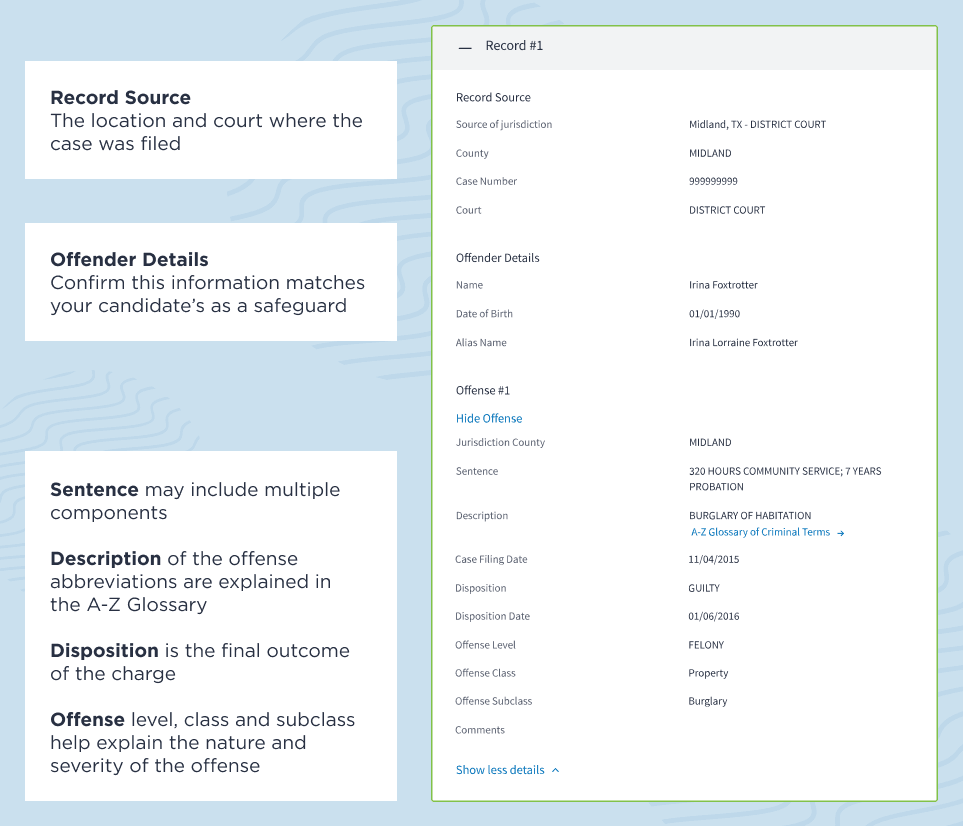Federal Background Checks: A Comprehensive Guide
Before bringing aboard a new employee, particularly someone in a position where they’re handling finances, you may want to conduct a federal criminal background check.
Resourcesarticles
Gayle Sato
10 min read
Information in a candidate’s background check is critical to your hiring process. A criminal background check can help reduce risk and maintain a secure workplace. But reading a criminal background check can be confusing.
These four steps will help you understand the terminology in criminal background checks, read them accurately, and use them in compliance with fair hiring laws.
The information contained in a candidate’s background check can be critical to your hiring process. The insights you gain there can help you reduce risk and ensure a secure workplace. But running a background check, which typically includes a criminal background check, is just one piece of the puzzle. Employers need to know how to read background check results and, perhaps even more important, how to use what they find in a criminal background check, to make informed decisions while remaining compliant with fair hiring laws.
Working with a consumer reporting agency (CRA) like GoodHire can help you access up-to-date information matched accurately to your candidates. It’s important to have procedures in place for candidates to provide written consent and address any inaccuracies in the criminal records you review, as required by law. Further, criminal background checks should be integrated into a fair, consistent and compliant hiring process.
GoodHire is here to help you better understand how to read criminal background checks accurately and use them fairly. Here are four steps to get you started.
What should you expect when you get a criminal background check? Depending on your needs, a background check report may include a search of national, federal, state, and county databases. Here’s how each of these breaks down:
National: Searches thousands of digital databases across the country to find offenses at state and county levels.
Federal: Searches all 94 federal courts in the country to look for federal crimes.
State: Searches statewide databases for criminal records originating from courts within a particular state.
County: Searches for digitized and non-digitized county records with the help of clerks, researchers, or automated databases.

Criminal background check reports may show felony and misdemeanor convictions, as well as whether an individual is listed on the sex offender registry, if that search is included. Here’s an overview of felony vs. misdemeanor convictions:
Felony charges are serious crimes, including murder, rape, burglary, assault, kidnapping, arson, and theft (based on value). Felonies may be further identified by class, either Class A through Class E or Level 1 through Level 5, depending on your state. Class A or Level 1 felonies are considered most serious.
Misdemeanor charges may include second-degree assault and burglary, trespassing, vandalism, indecent exposure, disorderly conduct, theft (based on value), issuing a bad check, filing false reports, and possession of a controlled substance (this could also be a felony, depending on the amount and the specific drug). Misdemeanors may be divided into Class A through Class C or Level 1 through Level 3, again depending on your state.
Dispositions also appear on a criminal background check, and indicate either the final outcome of the offense charge, or the current status of an arrest, prosecution, or case (if pending). The intricacies of dispositions vs. sentencing are the subject of their own article, which may be worth checking out if you’d like additional clarity.
A few terms related to dispositions can be especially confusing. For example, in a “deferred adjudication”, a person may have entered into a plea deal in which they agreed to plead “guilty” or “no contest” in exchange for the opportunity to complete probation or a diversion program such as community service or drug or alcohol treatment, and ultimately avoid conviction. A person who has a deferred adjudication has not been convicted, even though they may have pleaded “guilty.” The final outcome of their case has been deferred pending the completion (or failure to complete) their prescribed program. If the program is completed successfully, the charges will be dismissed.
You may also encounter the term “nolle prosse.” What does nolle prosse mean? Nolle prosse, or nolle prosequi, is Latin and loosely translates as “not willing to prosecute.” It refers to a case in which a prosecutor has declined to move forward with a case—for example, if they determine that the defendant is innocent or that there is not enough evidence for a conviction. When a disposition is nolle prosse, the case is considered dropped or dismissed.
To give you a clearer picture of how to read a criminal background check report, here’s a sample report from GoodHire and what you’ll find in each section:

Descriptions of the criminal record may include abbreviations or unfamiliar terms as well. Offense codes and abbreviations vary from state to state, but some of the most common examples can be found in the Center for Development of Security Excellence’s list of Common Abbreviations Used in Criminal Record Reports. GoodHire’s background checks provide a link to a list of common abbreviations directly on the candidate’s results report.
A & B – Assault and battery
EMBZ – Embezzlement
F1 through F6 – Felonies with F1 being most serious
OCI – Obstruction of criminal investigation
PL – Petty larceny
PV or PVB – Parole violator
RIOT – Rioting
UPRF – Unlawful possession or receipt of firearms
In addition to understanding how to read a criminal background check, knowing how and when to use criminal background checks as part of your hiring process is important. Employers must comply with federal and local fair hiring laws and regulations to ensure a fair, non-discriminatory hiring process. Among the laws and regulations to consider:
The FCRA requires employers to get written consent from a candidate before running background checks. Additionally, if the results of a criminal background check lead to denial of employment, the FCRA requires employers to follow specific adverse action steps.
EEOC guidance advises employers to conduct individualized assessments to make fair, informed decisions based on such factors as the nature and gravity of the offense, the time that’s passed since the offense, and the relevance of the offense to the job sought. Employers are also advised to delay criminal background checks until a conditional offer of employment has been extended.
Federal, state, and local “ban the box” and other fair hiring laws can restrict an employer’s use of criminal background information in the hiring process. These laws vary by state, county, and city and are based on both the employers’ and candidates’ locations. Before incorporating criminal background checks into your hiring process, familiarize yourself with all applicable laws and regulations.
Your company should have consistent and compliant hiring processes in place as well to prevent discrimination and to avoid litigation and penalties from federal or local agencies. Criminal background checks can be of great value to employers but only when they are applied fairly and compliantly.
One way to make the process of running and interpreting a criminal background check less mystifying—and more productive—is to work with a trusted employment screening provider like GoodHire. Reports from GoodHire include the most up-to-date, accurate information, which is vital when considering criminal records.
GoodHire also takes multiple steps to make reports easier for employers to read and understand. For example, different jurisdictions can use different names for the same offenses. GoodHire’s criminal background checks include standardized class and subclass categories. So, if you don’t recognize the name of the criminal offense and don’t have time to look up the relevant state’s criminal code to understand what it means, GoodHire’s classification system will help to give you an idea of the nature of the criminal record by showing categories like “financial/embezzlement” or “financial/forgery,” and “substance/marijuana use” or “substance/trafficking.”
Additional features that make GoodHire’s criminal record checks easier to read and easier to use:
Learn more about how GoodHire can help you access and use criminal background checks without confusion or compliance issues.

The resources provided here are for educational purposes only and do not constitute legal advice. We advise you to consult your own counsel if you have legal questions related to your specific practices and compliance with applicable laws.
Before bringing aboard a new employee, particularly someone in a position where they’re handling finances, you may want to conduct a federal criminal background check.
When reviewing a criminal background check, it’s important to understand how offenses are categorized by relative severity, class or level.